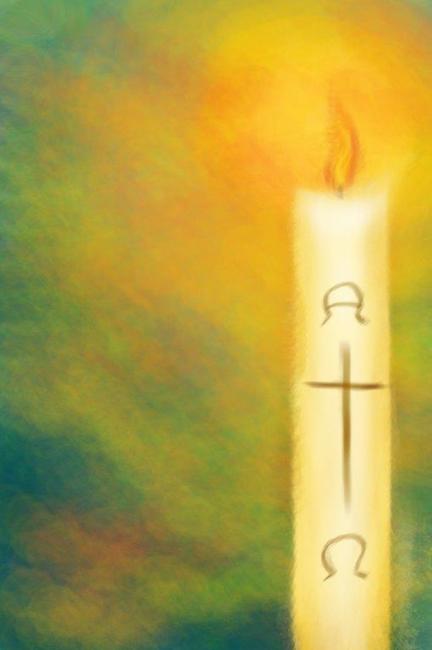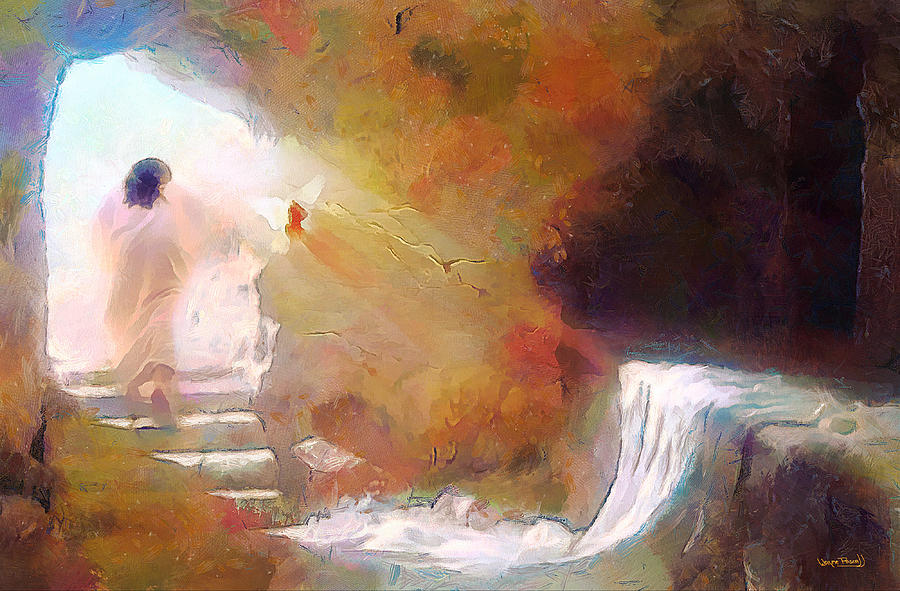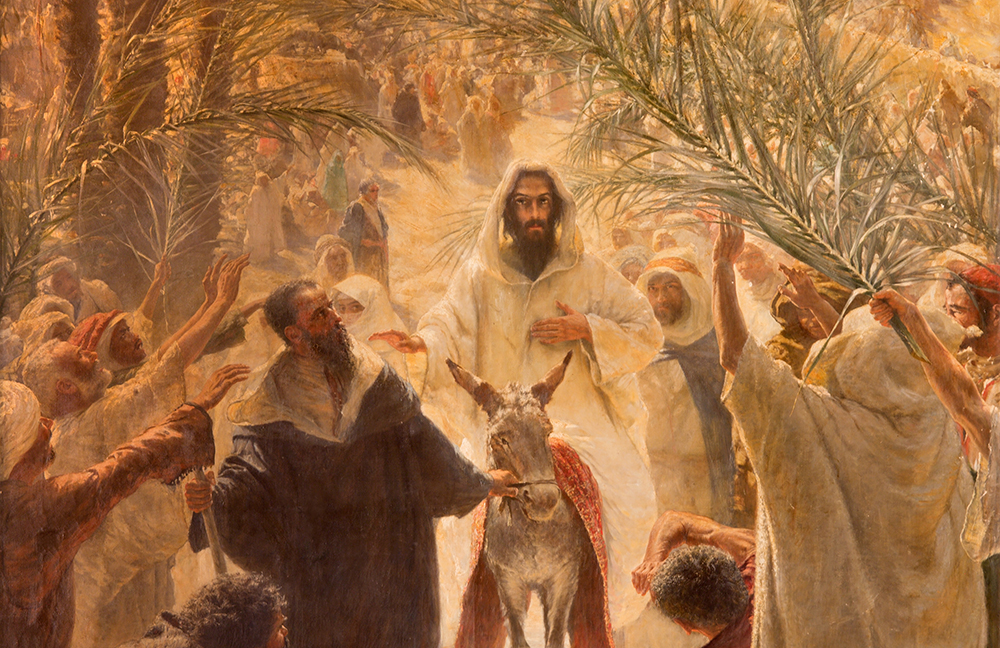
The Easter Vigil A B C
Readings: Genesis 1:1-2:2 Genesis 22:1-18 Exodus 14:15-15:1 Isaiah 54:5-14 Isaiah 55:1-11 Baruch 3:9-14, 32-4:4 Ezekiel 36:16-17a, 18-28 Romans 6:3-11 A: Matthew 28:1-10 B: Mark 16:1-7 C: Luke 24:1-12
On Holy Saturday night the Church celebrates the Easter Vigil commemorating Jesus’ resurrection in a service with an extended Liturgy of the Word of seven Old Testament readings, an epistle reading from Paul’s Letter to the Romans proclaiming Christian Baptism as the sacrament of Christ’s Resurrection, and the discovery of the empty tomb and announcement of the resurrection from one of the Synoptic Gospels. Ideally all the readings are to be done, but at a minimum three selections from the Old Testament should be read and the reading from Exodus recounting the escape through the Red Sea is never to be omitted.
The Old Testament readings recount the saving works of God for the people of Israel beginning with the defeat of darkness and chaos in the magnificent story of creation at the beginning of Genesis. The primordial condition is one of disorder and darkness: “the earth was a formless wasteland, and darkness covered the abyss, while a mighty wind swept over the waters.” In six parallel days God brings order and life out of the chaos simply by the word of his com-mand. On day one he creates light and separates it from darkness, naming them “day” and “night,” and on the parallel fourth day he creates the light bearing bodies: the sun, moon and stars to mark the fixed times, the days and the years and to govern the day and the night and to separate the light from the darkness. On day two God separates the waters by creating a dome (the sky), and on the parallel fifth day he populates the waters and the region beneath the dome of the sky with sea creatures and birds. On the third day God gathers the waters beneath the sky into its basin so that the dry land appears; he names the dry land “the earth” and the gathered water “the sea”, and then he commands the earth to bring forth vegetation. On the parallel sixth day he commands the earth to bring forth all kinds of living creatures and then creates humans in his “image” and “likeness” to rule by having dominion over the animal portion of creation. Repeatedly (seven times) we hear how God saw that what he made was good, and in fact there is no hint of violence in this world as both humans and animals are given the seed-bearing plants for their food. The account ends with the God resting on the seventh day, the Sabbath which is to celebrate and enjoy God’s creation. This is the world order that we Christians long for in our Easter hope as we sing in the responsorial psalm: “Lord, send forth your Spirit, and renew the face of the earth” (Ps 104).
The second reading recounts the terrifying story of the testing of Abraham in the Binding of Isaac which culminates in the Lord’s oath promising Abraham abundant blessing for himself and “all the nations of the earth” because of his trusting obedience to the Lord’s command. The story is centered on Abraham’s faith expressed in his words to his beloved Isaac who poignantly asks his father, “Here are the fire and the wood, but where is the sheep for the holocaust?” Abraham answers, “Son, God himself will provide (yir’eh “see to”) the sheep for the holocaust.” Abraham’s faith is associated with the name of the place Moriah which is based on the verbal root” to see” (yr’) in Hebrew and is associated with Abraham’s naming of the place after he has passed the test and has spied a ram caught by its horns in the thicket to replace his son as the holocaust victim. We are told: “Abraham named the site Yahweh-yireh; hence people now say, ‘On the mountain the Lord will see.’” In Jewish exegetical tradition the site of Moriah is the future site of the Temple in Jerusalem and the lamb that replaces Isaac is associated with the Passover lamb whose blood enables the Israelites to escape from Egypt. For us Christian readers Isaac is a type of Christ who carries the wood of the sacrifice and is rescued from death by God’s command.
For Christians the story of the Red Sea crossing (Exodus 14:15ff) is symbolic of the waters of baptism and Christ’s saving victory over the forces of oppression and evil through his death and resurrection (cf. the epistle reading from Romans 6). For the Israelites passing through the waters is the path to salvation from the cruel oppression of the Pharaoh. Initially, they are terrified at the approach of his army and chariots and want to return to the security of Egypt, but the Lord commands Moses to tell the Israelites to “go forward” and to use his staff to “split the sea in two, that the Israelites may pass through it on dry land.” Through the Lord’s saving power they march “into the midst of the sea on dry land, with the water like a wall to their right and to their left.” As a divine warrior, the Lord then uses the waters of the sea to drown “the chariots and the charioteers of the Pharaoh’s whole army.” Fittingly, when the Israelites see “the great power that the Lord had shown against the Egyptians, they feared the Lord and believed in him and in servant Moses” and break into the lyrics of the Song of the Sea: “I will sing to the Lord, for he is gloriously triumphant;/ horse and chariot he has cast into the sea” (Ex 15:1).
The fourth reading from Isaiah 54 proclaims to the Babylonian exiles that the Lord of hosts, as husband and “Maker”, calls Zion/Jerusalem back “like a wife forsaken and grieved in spirit, a wife married in youth and then cast off.” For Christians, this reading encapsulates our whole Lenten-Easter observance of returning to the Lord in trust for his unfailing saving purpose for us as a redeemed community. As Jerusalem’s redeemer, the Lord says “For a brief moment I abandoned you,/ but with great tenderness I will take you back.” His renewed covenant with the Holy City is “like the days of Noah” when the Lord promised “the waters of Noah should never again deluge the earth.” Even though the mountain and hills may be shaken, the Lord’s covenant fidelity will never abandon the city and temple which he will rebuild in precious stones and where “all your children shall be taught by the Lord” so that “justice shall be established,/far from fear of oppression,/ where destruction cannot come near you.”
The fifth reading also from Isaiah 55 is the Lord’s universal invitation to the banquet of life in the restored temple in Jerusalem. His saving word will satisfy the thirst and hunger of all “without paying and without cost.” Those who come to him and find life are assured of the benefits of the everlasting covenant with David: “As I made him a witness to the peoples,/ a leader and commander of nations,/ so shall you summon a nation you knew not,/ and nations that knew you not shall run to you,/ because of the Lord, your God,/ the Holy One of Israel, who has glorified you.” With special urgency, the prophet exhort us to “seek the Lord while he may be found” by forsaking wickedness and turning to the Lord for mercy. If we doubt our worthiness, we are assured that the Lord’s ways are above our ways and that his word will achieve the end for which it was sent. “For just as from the heavens the rain and snow come down/ and do not return there till they have watered the earth, . . .so shall my word be that goes forth from my mouth;/ my word shall not return to me void,/ but shall do my will, achieving the end for which I sent it.”
The Baruch reading is an exhortation to conversion in the form of a hymn praising Wisdom found in the Torah as the way to God for the exiles who have forsaken “the fountain of wisdom.” Had the exiles “walked in the way of God,” they “would have dwelt in enduring peace.” Now they must “learn” where prudence is . . . so that they may know “where are length of days, and life/ where light of the eyes, and peace.” Only the creator God knows Wisdom and he “has given her to Jacob, his servant” in the form of “the book of the precepts of God, the law that endures forever.” So Jacob is invited to “Turn . . . and receive her: walk by her light toward splendor.”
The seventh and last Old Testament reading from the Book of the Prophet Ezekiel announces the reason for the exile—Israelites’ defiling of their land by their conduct and deeds—and the Lord’s intention for the sake of his holy name to take them back to their own land. Using priestly language of purification, the Lord announces to the exiles: “I will sprinkle clean water upon you to cleanse you from all your impurities, and from all your idols I will cleanse you.” And, in order that they may now keep his covenant, he promises, “I will give you a new heart and place a new spirit within you, taking from your bodies your stony hearts and giving you natural hearts.” He also promises the gift of the spirit so they may live by his law and renew the covenant: “you shall be my people, and I will be your God.” The symbols of water, change of heart, the gift of the spirit and covenant renewal all point to the baptism of catechumens and renew our baptismal vows latter the Easter Vigil service.
In the Epistle reading from Romans, Paul is responding to a possible objection to his gospel of salvation through faith in Christ. The question is: does Paul’s gospel encourage continuation in sin “that grace may abound” (6:1)? Paul’s answer is a definitive “No!” He substantiates this by a reflection on the effects of the baptism Christian converts received. Paul interprets Christian baptism, as an entrance into the death and resurrection of Christ which leads to walking in “newness of life.” It also involves an ethical conversion. The old self “was crucified with him (Christ) . . . that we might no longer be in slavery to sin.” Baptized Christians, freed from sin, must now live in the power of Christ’s resurrection. Paul concludes, “Consequently, you too must think of yourselves as being dead to sin and living for God in Christ Jesus.”
The Gospels for the Easter Vigil are the accounts of the discovery of the empty tomb by the faithful women, always including Mary Magdalene, in the respective synoptic gospels: Matthew for the A Cycle, Mark for the B Cycle, and Luke for the C Cycle. Although all the narratives share certain features—the women coming to the tomb and finding the stone rolled back, their encounter with a young man/angel/young men who tell them not to be afraid and announce that the crucified Jesus has been raised from the dead, and some account of announcing the good news to the disciples—each also has distinctive features. Matthew’s account has a mini-apocalyptic tone with a great earthquake and an angel descending from heaven to roll back and stone and sit upon it. Mark’s account has the young man dressed in a white robe sending the amazed women to the disciples and Peter with the message “that he (the risen Jesus) is going before you to Galilee; there you will see him as he told you” (cf. Mk 14:28). Luke has the two men in dazzling apparel telling the women to remember that Jesus told them while he was still in Galilee “that the Son of man must be delivered into the hands of sinful men, and be crucified, and on the third day rise,” a message which the apostles do not believe because they think it was an idle tale.




 Holy Thursday A B C
Holy Thursday A B C



